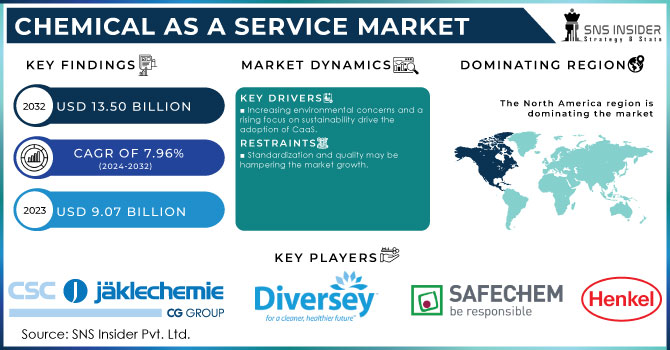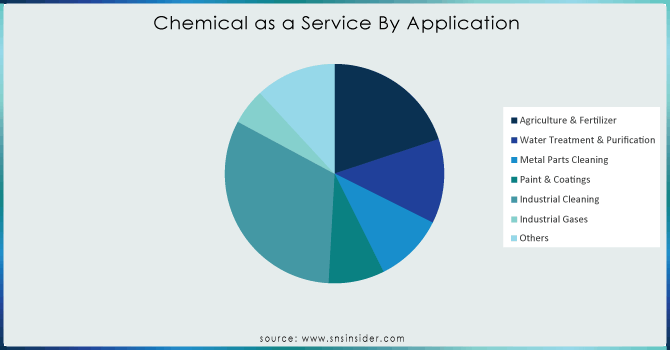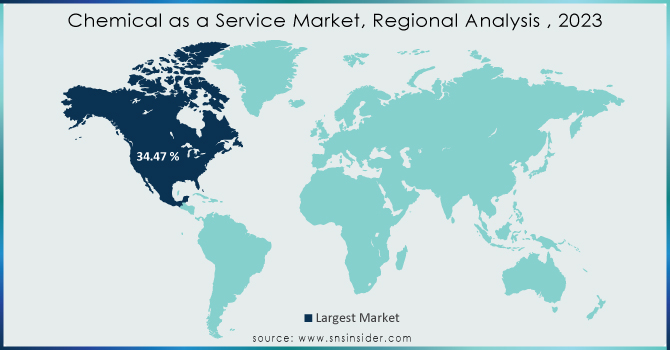Chemical as a Service Market Size:

Get More Information on Chemical as a Service Market - Request Sample Report
Chemical as a Service Market Overview:
The Chemical as a Service Market Size was valued at USD 9.07 billion in 2023 and is expected to reach USD 13.50 billion by 2032 and grow at a CAGR of 7.96% over the forecast period 2024-2032.
Environmental responsibility is a major driving force, as chemical as a service models promote efficient chemical usage, minimizing waste and environmental impact. Furthermore, it offers compelling economic advantages. By leasing chemicals instead of purchasing them outright, companies can reduce upfront costs and simplify management. This can translate to substantial cost savings in the long run
Chemical service providers handle the complexities of storage, disposal, and liability, allowing users to concentrate on their core operations. Finally, chemical as a service provider often boasts expert knowledge on chemical selection, application, and best practices. This expertise can be invaluable for users, helping them optimize their chemical usage and achieve greater efficiency.
According to the Department of Chemicals and Petrochemicals, in India the government agencies' utilization of installed capacity for chemicals reduced from 79% in 2020 to 72 percent in 2021, and for petrochemicals, it reduced from around 90% to 84 percent. A decrease in chemical consumption is expected to raise the chemicals as a service market growth.
The chemical as a service market is an emerging concept in the industry, and still establishing. The number of companies offering these services on a global scale remains limited. The United Nations Industrial Development Organization (UNIDO) estimates only around 100 companies worldwide have embraced chemical leasing as part of their business model. While most chemical as a service provider currently operates at a local or regional level, a select few, like the US-based Diversey Holdings LTD., are successfully expanding their reach internationally. This limited global presence indicates a vast, unexplored market brimming with opportunity.
Developed markets, like the U.S., present a particularly fertile ground for chemicals as a service to grow. These regions boast established industries that are heavily reliant on chemicals automotive, fertilizer, and general chemical production. These industries stand to gain significant benefits from the cost-saving and efficiency-enhancing advantages of chemicals as a service. Therefore, these benefits may increase the chemical as a service market growth.
Market Dynamics
Drivers
-
Increasing environmental concerns and a rising focus on sustainability drive the adoption of CaaS.
The flow is turning towards environmental responsibility, and the chemical as a service model is rising as a sustainability space. Chemical as a service plays a role in efficient chemical usage, a critical factor in curbing waste. Chemical service providers act as custodians of these resources, meticulously optimizing the amount of chemicals used throughout each step of the process. This meticulous minimization of waste translates directly to a reduced environmental impact for industries that are heavily reliant on chemicals.
As sustainability is at the top of the agenda across various sectors, chemical as a service positions itself as a powerful ally, aligning with the global movement towards an eco-friendly future. The escalating tide of environmental concerns and the ever-sharpening focus on sustainability are interim as a powerful thing that drives the adoption of chemical as a service model.
Chemical service providers act as reliable custodians, meticulously analyzing and optimizing the amount of chemicals used throughout each step of a process. This focus on minimizing waste translates directly to a reduced environmental footprint for industries that rely heavily on chemicals. As the imperative for sustainability takes center stage across numerous sectors, chemical as a service seamlessly aligns with this global movement towards an eco-friendly future. By offering a practical and potent solution, chemical as a service empowers companies to lessen their environmental impact.
Restrain
-
Standardization and quality may be hampering the market growth.
Ensuring consistent quality control in chemical as a service presents a unique hurdle. The outsourcing nature of the model can lead to inconsistencies if different service providers have varying quality control procedures. Additionally, users might have limited control over the process, raising concerns about meeting specific needs and achieving consistent quality.
Chemical as a Service Market Segmentation
By Application
Industrial cleaning segment held the largest market share of the chemical as a service around 31.96% share in 2023, and is expected to keep growing in the upcoming years. The chemical as a service model is demonstrating its value beyond its initial venture into cleaning vessels, pipes, reactors, and metal parts. Industrial operators are increasingly recognizing the economic advantages and convenience offered by chemical as a service. Instead of the traditional model of purchasing chemicals and managing separate labor costs for cleaning, chemical as a service allows them to subscribe to a service that streamlines the process and has the potential to reduce overall expenses.
However, the agricultural and fertilizer segment is to become the fastest-growing sector within chemical as a service, this surge is propelled by the global expansion of the agricultural industry. As precision farming techniques and innovative technologies gain momentum, agriculturists are turning to new business models like chemical as a service. These services allow farmers to leverage a range of chemicals, including fertilizers, without the need for upfront purchases. By subscribing to chemical as a service, farmers not only benefit from expert application but also free up valuable time and resources previously dedicated to fertilizer application.
In essence, chemical as a service is evolving from a cleaning-centric solution into a versatile model that adapts to the changing needs of various industries such as, chemical services for water treatment. This win-win proposition is proving valuable for both industrial and agricultural sectors.

Need any customization research on chemical-as-a-service-market - Enquiry Now
Chemical as a Service Market Regional Analysis
North America accounted for a major market share of approx. 34.47% in chemical as a service market in 2023. The United States presents a fertile landscape for the burgeoning chemical as a service market, driven by a powerful combination of chemical services factors. A basis of this growth is the presence of a well-established chemical industry within the U.S. This industry acts as a powerhouse, providing chemical as a service provider with a readily available pool of expertise and resources.
Furthermore, the U.S. boasts a thriving ecosystem of major players across diverse industries, such as automotive, aerospace, and healthcare. These industries are perfectly positioned to capitalize on the advantages of chemical as a service for applications like cleaning, washing, and degreasing metal parts in the coming years. The convenience, cost-effectiveness, and potential environmental benefits of chemical as a service make it an attractive proposition for U.S. industries seeking to streamline their operations and achieve greater efficiency.

Key Players
Henkel AG & Co. KGaA, CSC JÄKLECHEMIE GmbH & Co. KG., Safechem Europe Gmbh, Diversey Holdings Ltd., Ecolab Inc., Polikem, BASF SE, Hydrotechnik, Haas TCM, PPG Industries, Quaker Chemical, Spheres, and Others.
Recent Development:
-
In May 2023, Dow Chemical partnered with CAS to launched CAS ScifFinder-n, it optimizes searching for chemical molecules over 200 million compounds.
-
In May 2022, Sphera done a strategic partnership with BASF. This partnership focused to offer a comprehensive and automated solution to manufacturing and chemical companies and increase its product portfolio with accuracy, speed, and efficiency.
-
In May 2022, - ReliefWeb, a US-based humanitarian information source on international crises and disasters, estimates that every year, 380 billion cubic meters of municipal wastewater are produced worldwide. It is anticipated that wastewater production will rise by 24% by 2030 and 51% by 2050. Thus, the market for chemicals as services is growing as a result of the growing environmental issue.
| Report Attributes | Details |
| Market Size in 2023 | US$ 9.07 billion |
| Market Size by 2032 | US$ 13.50 Billion |
| CAGR | CAGR of 7.96 % From 2024 to 2032 |
| Base Year | 2023 |
| Forecast Period | 2024-2032 |
| Historical Data | 2020-2022 |
| Report Scope & Coverage | Market Size, Segments Analysis, Competitive Landscape, Regional Analysis, DROC & SWOT Analysis, Forecast Outlook |
| Key Segments | •By Application (Agriculture & Fertilizer, Paint & Coatings, Industrial Cleaning, Industrial Gases, Water Treatment & Purification, Metal Parts Cleaning, and Others) |
| Regional Analysis/Coverage | North America (US, Canada, Mexico), Europe (Eastern Europe [Poland, Romania, Hungary, Turkey, Rest of Eastern Europe] Western Europe] Germany, France, UK, Italy, Spain, Netherlands, Switzerland, Austria, Rest of Western Europe]), Asia Pacific (China, India, Japan, South Korea, Vietnam, Singapore, Australia, Rest of Asia Pacific), Middle East & Africa (Middle East [UAE, Egypt, Saudi Arabia, Qatar, Rest of Middle East], Africa [Nigeria, South Africa, Rest of Africa], Latin America (Brazil, Argentina, Colombia, Rest of Latin America) |
| Company Profiles | Henkel AG & Co. KGaA, CSC JÄKLECHEMIE GmbH & Co. KG., Safechem Europe Gmbh, Diversey Holdings Ltd., Ecolab Inc., Polikem, BASF SE, Hidrotecnik, Haas TCM, PPG Industries, Quaker Chemical, Spheres, and Others. |
| Key Drivers | • Increasing environmental concerns and a rising focus on sustainability drive the adoption of CaaS |
| RESTRAINTS | • Standardization and quality may be hampering the market growth. |

